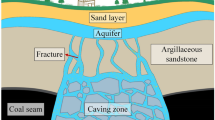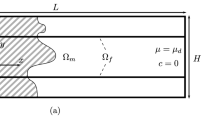Abstract
Beginning in 1995, the codes \(\hbox {d}^{3}\hbox {f}\) (distributed density driven flow) and \(\hbox {r}^{3}\hbox {t}\) (radionuclides, reaction, retardation, and transport) for modeling density-driven groundwater flow and nuclide transport using UG toolbox are developed in the framework of several joint projects. During this time, the codes were substantially extended as well as numerically improved, and the development is still ongoing. Now, \(\hbox {d}^{3}\hbox {f}\) and \(\hbox {r}^{3}\hbox {t}\) are no longer restricted to modeling of porous media, they also may be used for fractured rock. These are powerful tools that are able to handle salt and heat transport, salt concentrations up to saturation and complex hydrogeological structures with high permeability contrasts.







Similar content being viewed by others
References
Bastian, P., Wittum, G.: Robustness and adaptivity: the UG concept. In: Hemker, P., Wesseling, P. (eds.) Multigrid Methods IV, Proceedings of the Fourth European Multigrid Conference (1994)
Bear, J.: Dynamics of Fluid in Porous Media. Dover Publications, Inc., New York (1972)
Birken, K.: Ein Modell zur effizienten Parallelisierung von Algorithmen auf komplexen, dynamischen Datenstrukturen. PhD Thesis, Universität Stuttgart (1998)
Birthler, H., Fein, E., Schneider, A.: Validierung von Einzeleffekten in Grundwassermodellen. FKZ 02 E 8865 0, Gesellschaft für Anlagen und Reaktorsicherheit (GRS) mbH, GRS-150, Braunschweig 2000, www.grs.de
Fein, E.: Statusreport Grundwasserprogramme mit variabler Dichte, FKZ KWA 5901 6, Forschungszentrum für Umwelt und Gesundheit (GSF). Institut für Tieflagerung, Abteilung Endlagersicherheit, Bericht 31/91, Braunschweig (1991)
Fein, E.: Entwicklung eines schnellen Programms zur Modellierung von Grundwasserströmungen mit variabler Dichte, Fachliches Feinkonzept, FKZ 02 E 8532 1, Forschungszentrum für Umwelt und Gesundheit (GSF). Institut für Tieflagerung, Abteilung Endlagersicherheit, Bericht 3/93, Braunschweig (1993)
Fein, E., Schneider, A. (eds.) d\(^{3}\)f - Ein Programmpaket zur Modellierung von Dichteströmungen. Abschlussbericht. FKZ 02 C 0465 0, Gesellschaft für Anlagen und Reaktorsicherheit (GRS) mbH, GRS-139, Braunschweig 1999, www.grs.de
Fein, E. (ed.): Software Package r\(^{3}\)t. Model for Transport and Retention in Porous Media. FKZ 02 E 9148/2, Gesellschaft für Anlagen- und Reaktorsicherheit (GRS) mbH, GRS-192, Braunschweig 2004, www.grs.de
Fein, E., Kröhn, K.-P., Noseck, U., Schneider, A.: Modelling of field-scale pollutant transport. FKZ 02 E 9934, Gesellschaft für Anlagen und Reaktorsicherheit (GRS) mbH, GRS-231, Braunschweig 2008, www.grs.de
Frolkovič, P., Knabner, P., Tapp, C., Thiele, K.: Adaptive finite volume discretization of density driven flows in porous media. Preprint 220, Institut für Angewandte Mathematik, Universität Erlangen-Nürnberg, FR Germany, 1997. Lecture Notes to INRIA Rocquencourt: Transport de contaminants multiespeces en milieux poreux, 2–6 June 1997
Frolkovic, P.: Flux-based methods of characteristics for coupled transport equations in porous media. Comput. Vis. Sci 6, 173–184 (2004)
Frolkovič, P., Wehner, C.: Flux-based level set method on rectangular grids and computations of first arrival time functions. Comput. Vis. Sci. 12, 297–306 (2009)
Grillo, A., Logashenko, D., Stichel, S., Wittum, G.: Simulation of density-driven flow in fractured porous medis. Adv. Water Resour. 33(12), 1494–1507 (2010)
Grillo, A., Lampe, M., Wittum, G.: Three-dimensional simulation of the thermohaline-driven buoyancy of a brine parcel. Comput. Vis. Sci. 13, 287–297 (2010)
Grillo, A., Lampe, M., Wittum, G.: Modelling and simulation of temperature-density-driven flow and thermodiffusion in porous media. J. Porous Media 14(8), 671–690 (2011)
Johannsen, K.: An aligned 3D-finite-volume method for convection-diffusion problems. Notes on Num. Fluid Mech. 59, 227–243 (1997)
Johannsen, K.: Numerische Aspekte dichtegetriebener Strömung in porösen Medien. Professorial dissertation (habilitation) (2004)
Keesmann, S., Noseck, U., Buhmann, D., Fein, E., Schneider, A.: Modellrechnungen zur Langzeitsicherheit von Endlagern in Salz- und Granitformationen. FKZ-02 E 9239. Gesellschaft für Anlagen- und Reaktorsicherheit (GRS) mbH, GRS-206, Braunschweig, 2005, www.grs.de
Kröhn, K.-P.: Qualifying a computer program for simulating fracture flow. Radionuclide transport modelling. Performance assessment of repositories in clays. FKZ 02 E 10558 (BMWi), (same issue, 2012)
Lang, S., Wittum, G.: Large-scale density-driven flow simulations using parallel unstructured Grid adaptation and local multigrid methods. Concurr. Comput. Pract. Exp. 17, 1415–1440 (2005)
Musuuza, J.L., Attinger, S., Radu, F.A.: An extended stability criterion for density-driven flows in homogeneous porous media. Adv. Water Resour. 32, 796–808 (2009)
Musuuza, J., Radu, F., Attinger, S.: The effect of dispersion on the stability of density-driven flows in homogeneous porous media. Adv. Water Resour. 34(3), 417–432 (2011)
Nägel, A., Falgout, R.D., Wittum, G.: Filtering algebraic multigrid and adaptive strategies. Comput. Vis. Sci. 11(3), 159–167 (2008)
Noseck, U. et al.: Realistic integration of sorption processes in transport codes for long-term safety assessments. FKZ 02 E 10518 and 02 E 10528. Gesellschaft für Anlagen- und Reaktorsicherheit (GRS) mbH, GRS-297, Braunschweig (2013)
Ogata, A., Banks, R.B.: A solution of the differential equation of longitudinal dispersion in porous media. U.S. Geol. Surv. Prof. Paper 11-A, 1961, www.grs.de
Oswald, S.: Dichteströmungen in porösen Medien: Experimente und Modellierung. Dissertation, ETH Zürich, Nr. 12812 (1998)
Rübel, A., Becker, D.-A., Fein, E.: Radionuclide transport modelling. Performance assessment of repositories in clays. FKZ 02 E 9813 (BMWi), Gesellschaft für Anlagen- und Reaktorsicherheit (GRS) mbH, GRS 228, Braunschweig 2007, www.grs.de
Rumpf, M., Wierse, A.: GRAPE, Eine Interaktive Umgebung für Visualisie-rung und Numerik. Informatik, Forschung und Entwicklung 7, 145–151 (1992)
Schelkes, K.: Modelluntersuchungen zur Bewegung des Grundwassers bei vom Salzgehalt abhängiger Wasserdichte—Fallstudien und Modellvalidierung im Hinblick auf die Langzeitsicherheit von Endlagern für radioactive Abfälle, Abschlussbericht zum Forschungsvorhaben 02 E 8301, Bericht Archiv-Nr. 114 249, Bundesanstalt für Geowissenschaften und Rohstoffe, Hannover (1995)
Schneider, A., Birthler, H.: Modellrechnungen zur großräumigen dichteabhängigen Grundwasserbewegung. FKZ 02 C 0628 4, Gesellschaft für Anlagen- und Reaktorsicherheit (GRS) mbH, GRS-191, Braunschweig (2004)
Schneider, A. (ed.): Enhancement of the codes \(\text{ d }^{3}\text{ f }\) and \(\text{ r }^{3}\text{ t }\), FKZ 02 E 10336 (BMWi), Gesellschaft für Anlagen- und Reaktorsicherheit (GRS) mbH, GRS-292, Braunschweig 2012, www.grs.de
Stichel, S., Logashenko, D., Grillo, A., Reiter, S., Lampe, M., Wittum, G.: Numerical methods for flow in fractured porous media. Accepted for publication in J. M. P. Q. Delgado (ed.), Heat and Mass Transfer in Porous Media, Advanced Structured Materials 13, Springer-Verlag (2011)
Acknowledgments
This work was funded by the German Federal Ministry of Economics and Technology (BMWi) under the contract no. 02 E 10558. The code development and qualification was funded by the German Federal Ministry for Education, Research and Technology (BMFT), since 1998 by the Ministry for Economics and Labour and since 2002 by the Ministry for Economics and Technology. Grateful thanks are due, too, to my colleagues Judith Flügge, Sabine Spießl, Sven Keesmann and Matthias Küntzel, and to all colleagues who have been working over the years within the projects mentioned above in the working groups of Gabriel Wittum, Wolfgang Kinzelbach, Peter Knabner, Dietmar Kröner, Werner Zielke, Martin Rumpf, Sabine Attinger and Olaf Kolditz. The paper is dedicated to Eckhard Fein who initiated the development of \(\hbox {d}^{3}\hbox {f}\), and looked after the continuous advancement through a great many of years.
Author information
Authors and Affiliations
Corresponding author
Additional information
Communicated by Gabriel Wittum.
This paper is dedicated to our former colleague Eckhard Fein who suddenly died on September 5th 2009.
Rights and permissions
About this article
Cite this article
Schneider, A., Kröhn, KP. & Püschel, A. Developing a modelling tool for density-driven flow in complex hydrogeological structures. Comput. Visual Sci. 15, 163–168 (2012). https://doi.org/10.1007/s00791-013-0207-2
Received:
Accepted:
Published:
Issue Date:
DOI: https://doi.org/10.1007/s00791-013-0207-2




